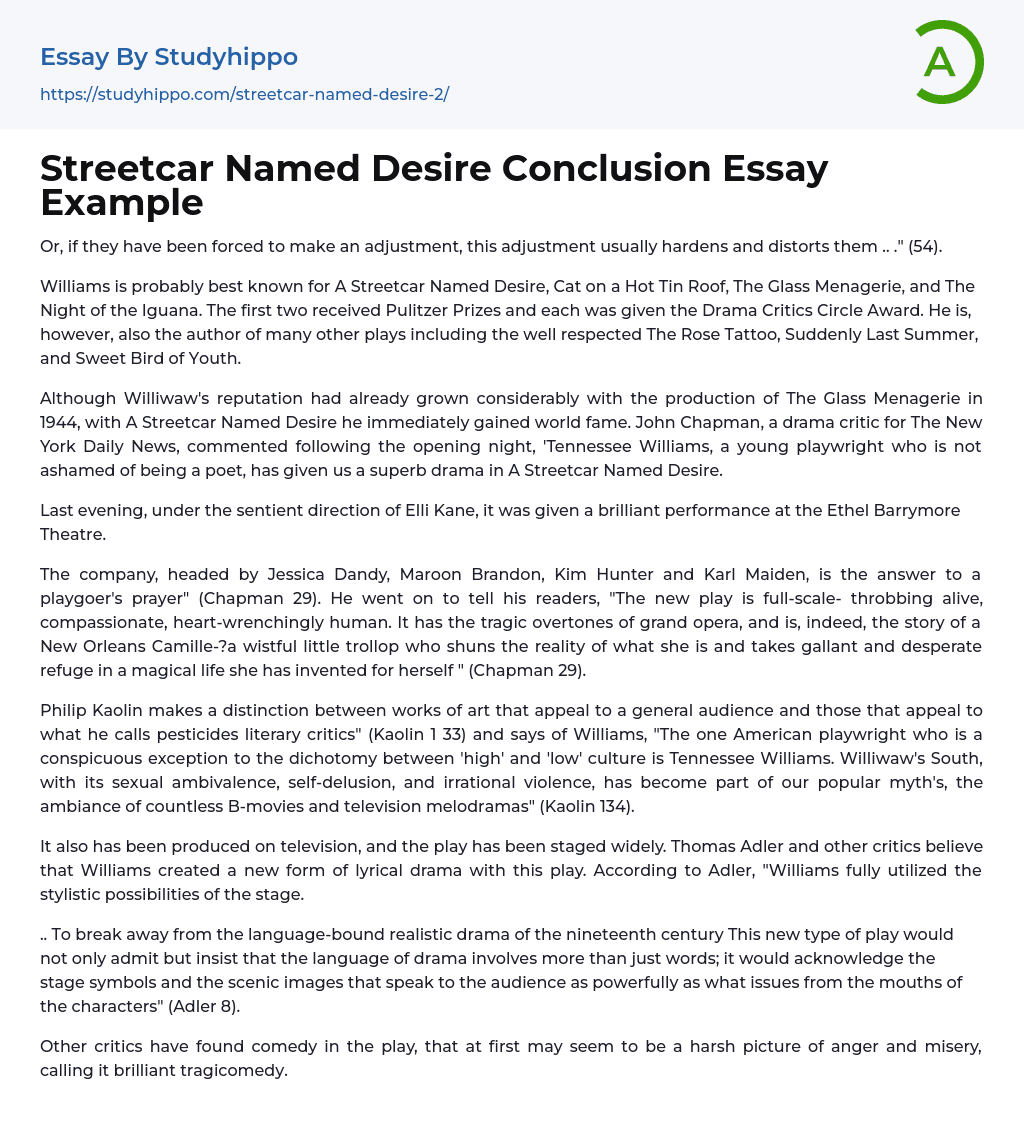Or, if they have been forced to make an adjustment, this adjustment usually hardens and distorts them .. ." (54).
Williams is probably best known for A Streetcar Named Desire, Cat on a Hot Tin Roof, The Glass Menagerie, and The Night of the Iguana. The first two received Pulitzer Prizes and each was given the Drama Critics Circle Award. He is, however, also the author of many other plays including the well respected The Rose Tattoo, Suddenly Last Summer, and Sweet Bird of Youth.
Although Williwaw's reputation had already grown considerably with the production of The Glass Menagerie in 1944, with A Streetcar Named Desire he immediately gained world fame. John Chapman, a drama critic for The New York Daily News, commented following the opening night, 'Tennessee Williams, a young playwright who is not asham
...ed of being a poet, has given us a superb drama in A Streetcar Named Desire.
Last evening, under the sentient direction of Elli Kane, it was given a brilliant performance at the Ethel Barrymore Theatre.
The company, headed by Jessica Dandy, Maroon Brandon, Kim Hunter and Karl Maiden, is the answer to a playgoer's prayer" (Chapman 29). He went on to tell his readers, "The new play is full-scale- throbbing alive, compassionate, heart-wrenchingly human. It has the tragic overtones of grand opera, and is, indeed, the story of a New Orleans Camille-?a wistful little trollop who shuns the reality of what she is and takes gallant and desperate refuge in a magical life she has invented for herself " (Chapman 29).
Philip Kaolin makes a distinction between works of art that appeal to a general audience and thos
that appeal to what he calls pesticides literary critics" (Kaolin 1 33) and says of Williams, "The one American playwright who is a conspicuous exception to the dichotomy between 'high' and 'low' culture is Tennessee Williams. Williwaw's South, with its sexual ambivalence, self-delusion, and irrational violence, has become part of our popular myth's, the ambiance of countless B-movies and television melodramas" (Kaolin 134).
It also has been produced on television, and the play has been staged widely. Thomas Adler and other critics believe that Williams created a new form of lyrical drama with this play. According to Adler, "Williams fully utilized the stylistic possibilities of the stage.
.. To break away from the language-bound realistic drama of the nineteenth century This new type of play would not only admit but insist that the language of drama involves more than just words; it would acknowledge the stage symbols and the scenic images that speak to the audience as powerfully as what issues from the mouths of the characters" (Adler 8).
Other critics have found comedy in the play, that at first may seem to be a harsh picture of anger and misery, calling it brilliant tragicomedy.
With the tragic implications of so many events in Streetcar, one is tempted simply to label the play a tragedy, if an imperfect one. What rises again and again, however, to contradict such a position is a comic spirit that continuously puts the audience off balance.
Rather than viewing these comic elements as imperfections in a purely tragic mode, then, or the tragic events as weak melodramatic elements in a comic mode, our appraisal should encompass both modes and allow Williams
his tragicomic stance with all of its irreconcilability's" (Redbrick 93). STAGING OF THE PLAY Tennessee Williams gives very explicit directions as to how A Streetcar Named Desire is to be staged: "The exterior of a two-story corner building on a street in New Orleans which is named Elysian Fields and runs between the L & N tracks and the river.
The section is poor but, unlike corresponding sections in other American cities, it has a raffish charm. The houses are mostly white frame, weathered grey, with rickety outside stairs and galleries and quaintly ornamented gables.
This building contains two flats, upstairs and down. Faded white stairs ascend to the entrances of both" (13). Later he describes the unusual relationship between an outer wall of the house and street, "Depending on the location of the action, the audience sees either the inside or the street and outside of the house: A light goes on behind the blind, turning it light blue.
Balance slowly follows her into the downstairs flat.
The surrounding areas dim out as the interior is lighted" (16). It is important as one reads the play to realize that sometimes we can see the street and the outside of the house; and, sometimes, a wall of the house becomes transparent, and we see inside the house. When the lights fade on the gauzy, shimmers exterior and rise on the inside two rooms of the apartment, the contrast from the beauty-?even beauty in decay-?is startling.
- A Doll's House essays
- A Midsummer Night's Dream essays
- A raisin in the sun essays
- A Streetcar Named Desire essays
- An Inspector Calls essays
- Death of a salesman essays
- Everyman essays
- Fences essays
- Hamlet essays
- Hedda Gabler essays
- Iago essays
- King Lear essays
- Macbeth essays
- Much ado about nothing essays
- Oedipus Rex essays
- Oedipus The King essays
- Othello essays
- Pygmalion essays
- Romeo And Juliet essays
- Tartuffe essays
- The glass menagerie essays
- The Importance of Being Earnest essays
- The Merchant Of Venice essays
- The Taming of The Shrew essays
- Twelfth Night essays
- Waiting For Godot essays
- Ambition essays
- Anger essays
- Betrayal essays
- Boredom essays
- Confidence essays
- Courage essays
- Desire essays
- Disgrace essays
- Doubt essays
- Empathy essays
- Fairness essays
- Fear essays
- Feeling essays
- Forgiveness essays
- Grief essays
- Guilt essays
- Happiness essays
- Harmony essays
- Hate essays
- Honesty essays
- Honor essays
- Hope essays
- Humanity essays
- Inspiration essays




